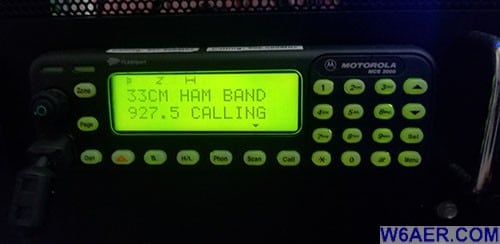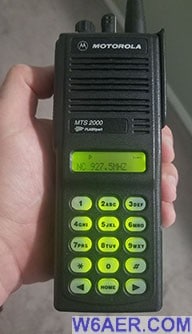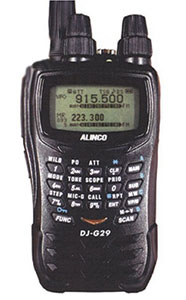If you have been thinking about getting on to 900MHz (33cm) Ham Bands or are active but want to find out more, this is the page is where you want to be.
I don't claim to be an expert in this area but I will share what I have learned, what I now know, what I use and why I picked what I picked. Hardware is very limited on this band, as are repeaters at this point and I think many are just scared due to lack of information out there. I am hoping to change this a bit here. I would love to see more activity on this highly underutilized band!
Here is a video based on this page on my YouTube channel @MaximumRF

Background on 900MHz
The 902 MHz to 928 MHz range has been allocated to hams on the secondary basis meaning, we have to accept interference from other sources as we are not the primary users of the band. All you need is a technician license and you are good to go! You do not need to be a general or extra class license to operate here so if you are licensed, you are ready to rock!
The propagation is very similar to that of the 440 (70cm) band, in fact some people think it is better depending on where you operate, due to different absorption and paths the signal takes. The band is widely used for experimentation, there is even ATV (Amateur Television) or Ham TV as it is sometimes called on here as well as on 70cm and 1.2GHz. If you are interested in this topic, check out my pages on Amateur Television.
On Repeaters, depending on where you live you will find a -12MHz or likely a -25MHz split/offset. You can find the current San Francisco Bay Area Repeater Frequencies for 900MHz on my website as well as the VHF/UHF Bandplan to help you get started.
Simplex Frequency spacing is 12.5kHz
900MHz Radio Hardware
As far as hardware there are a few ways you can go about it. Build or modify existing hardware or get something that can be re-programmed. I went the easy way about it most of the time but have tried it all. Here is a list of what is currently around and easiest to deal with:
- AlincoDJ-G29T - The only handheld for amateur radio market!
- Down East Microwave Transverters - Does SSB/CW also!
- Q5 Signal Transverters - Much like the above
- GE 900 MHz MPA/MTL Portable
- Kenwood TK981 900MHz radios
- Kenwood TK481 900MHz radios
- Motorola MCS2000 Mobile 900MHz version
- Motorola MTS2000 portable 900Mz version ( Pictured on the RIGHT)
- Motorola Professional Series 9250 (MTX9250)
- Motorola GTX 900 Portables & Mobiles
Basically with minor exceptions comes down to Motorola vs. Kenwood or the Alinco if you can still find one. All are good picks, but I decided to go the Motorola route after talking to people and hearing them for myself....at least at first. Currently I am using a Kenwood for FM operating due to much easier programming.
Keep in mind that since there is a lot of cellphone activity on or near these frequencies many times surplus cell phone tower gear, commonly found on eBay can be re-purposed. Including Amplifiers, antennas and such. It is a goldmine! Remember the old 900MHz cordless phones? They were on 927MHz (927.48-927.975MHz).
900MHz Programming & Software
To Program the Alinco Units (LEFT), you will have a very easy time, but you have to find a radio first. They are no longer made. They covered both the 900MHz band as well as the 225MHz (1.25m) band. Be ready to pay a pretty penny for a used one. Personally I think it was a mistake to discontinue this model.
To Program the Down East Microwave Units or the Q5 Signal units there is nothing to them. They are transverters so you can use your existing HF radio. And if you are lucky enough to own a FlexRadio, you get the waterfall and many extras. Splits/offsets are highly configurable on most rigs. Attach this to a modified cell amplifier and you will be in 900MHz heaven.
To Program the Motorola Units you will need both hard to find software and a times specialized hardware. I have owned the MCS2000 (Mobile/Ham Shack, the picture below) and the MTS2000 (Portable, the picture above). For BOTH you need to make sure you purchase the 900MHz capable version! See Red Box below for more information on this. Very Important!
The Motorola MTS2000 is capable of 902-928 MHz by hex editing MTSX.ODB in the software which you can find by an internet search, this will adjust the band limits. The same is true for the MCS where you edit the MCSX.ODB file. Once you do, the software for both is very similar.
There is lots of info on batlabs on this topic so I will not repeat it here.
There are many free hex editors online, all will work. Just be sure to backup the original and follow the step by step instructions. If you have used a hex editor before, you can do this in under a minute easily. I should mention that I only got the software to work under Windows XP (Yes, I know...) but you can grab an old junker as I did and throw the OS on there with the software and you should have no issues. Virtual machines (running the software in an emulator) are hit and miss. I have tried several and mostly struck out.

There are various versions of the MCS (mobile) and MTS (portable), model 3 is the most features (and buttons, so easy to recognize) and there are high and low power versions of the MCS, up to 30-35W.
NOT all MTS2000 will work on 900MHz, some do, some don't. There does not seem to be any easy way to tell unless you literally try. Might be good the first time around to purchase one which the seller has programmed already or is willing to program for you to make sure it works. I did this the first time as well. There are many sellers on eBay who throw in "free" programming. I had good luck with this.
Key takeaway, be sure to make sure these are the 900Mhz versions! Some complain about the microphone, an add-on microphone will fix it but I think the built in one is good enough. The squelch could be a little better but for what it is, they are good units.
As far as the MCS2000, I have owned several and these (Model 2 and 3) are rock solid! I even owned the model 3 with 35W out. It sounds the best from all of them and many do consider these as the must get for the shack or the car. With external speakers they are even better. Sometimes you will find a bundle online.
For the hardware you will need a cable and likely a box although there are now integrated units. These are called RIB Boxes at times. eBay is full of them and they are all about the same. Some are USB connected and therefore newer some are Serial. Same difference really, but you might as well go USB now-a-days. You can also make your own and there is lots of info in the forums I am listing below.
When Looking for a Motorola Radio you are looking for the letter "W" to make sure it does 900MHz! -- For Example M01WJN4PW6_N -- Transalation: Mobile, 01 Series, 896-941MHz, 30-35W, 2x14 Keypad, 12.5kHz spacing, Programable, High Specification. See chart link at bottom of the page.
To Program the Kenwood radios, the situation is similar. For Information on Kenwood Units, I would visit The Kenwood 900MHz Pages which is amazing if you choose to go that route. I have heard good things about these units and my experiences seem to match what I have heard. It really is a flip of a coin when it comes to Motorola vs. Kenwood in many cases depending on your intended usage and your technical experience.
For GE Units, your best bet is to search online. There is not much information on these and web pages seem to come and go. There is also a lot of repeater information out there on using these units ironically but that is mainly it.
900MHz Frequencies to know and avoid
Please be aware that the 900MHz band is not exclusive to hams, we are secondary users. Meaning you may encounter wireless phones (cordless phones which are still on the 900MHz band) as well as even wireless internet and so on. Frequency ranges to avoid, or at least keep are on can be viewed here: http://www.repeater-builder.com/tech-info/900mhz-frequencies-to-avoid.html
In my area, utilities use this band as well for smart meters.
Dependent where you live or who you ask, the National Calling Frequencies are:
- 902.1 MHz - CW/SSB Calling
- 903.1 MHz - Alternative CW/SSB Calling
- 902.5 MHz - Commonly Used FM Calling
- 906.5 MHz - FM Calling, Mostly retired is my understanding
- 927.6 MHz - Also Commonly Used FM Calling
Also, you can find the current San Francisco Bay Area Repeater Frequencies on this site using this link. If you have a repeater you want to add or find something outdated, kindly let me know so I can update it.
900MHz Antennas, Amplifiers & more
There are a TON of 900MHz Antennas around to be modified or even ready to purchase from your favorite ham radio antennae manufacturers such as Comet or Diamond. Keep in mind surplus cell phone gear! You will often see these at electronics flea markets or on eBay.
One of the best outdoor antennas I have found on Amazon is the LoRa 9dBi Omni Directional (900-930MHz), you can find it here: amzn.to/46l7m7e
As for Amplifiers, there are a few out there ready to go that cover the frequency ranges or you can modify it yourself. There is a ton of info on this out there and again eBay or your local swap meet is your friend.
Motorola, Down East Microwave, Q5 Signal and a local ham Jim, W6PQL have 33cm amps available. Please visit their sites for more information.
For More Information on 900MHz
Here are some links for even more information (new windows will open):
- Batlabs - Everything you need to know is here
- Down East Microwave - Transverters if you also want to do weak signal work
- Q5 Signal - Like above, great for SSB/CW and Digital!
- KB9MWR - Great Modification info, tons of links!
- MCS2000 Blogspot - Tons of Info!
- The Northern California 900MHz Repeater System - NC9RS
You can also find these on my Ham Related Links Page.
I hope you found this information useful and perhaps even got you to get your feet wet on 900MHz. If so shoot me a line, I would love to hear what you are doing with it and maybe even have a QSO. I am also always up for testing. Questions are welcome!
If you find something incorrect, have an update, or if there is something you would like to see added to the site, drop me a line here. I like to keep things as up-to-date and as accurate as possible. Thank you! - Lucas / W6AER






